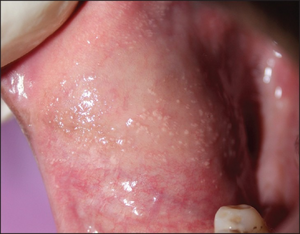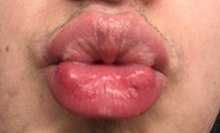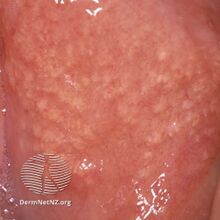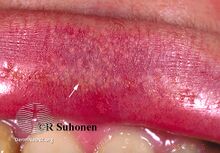Fordyce spots
| Fordyce spots | |
|---|---|
| Other names: Fordyce granules | |
 | |
| Fordyce granules inside of cheek | |
| Specialty | Dermatology |
| Symptoms | Painless white-yellow small bumps or spots in mouth or genitalia[1] |
| Usual onset | Puberty[1] |
| Causes | Unknown[2] |
| Diagnostic method | Visualisation[2] |
| Differential diagnosis | Genital warts, molluscum[2] |
| Frequency | Common[2] |
Fordyce spots are painless white-yellow small bumps or spots on the inside of the lips or cheeks, gums, or genitalia.[1][3] They are a normal sebaceous glands not associated with hair follicles.[2] There may be just one or a group of many.[1] Their appearance may cause psychological distress in some.[2]
The cause is unclear.[2] Diagnosis is based on their appearance.[2] Other conditions that may appear similar include genital warts and molluscum.[2]
Treatment is not required, beyond reassurance.[2] Attempts to remove them typically result in pain and scarring.[2] The spots are harmless.[2]
Fordyce spots are common and are present in around 80% of adults.[1] They are present in around 65% of uncircumcised males; typically on the inner side of the foreskin and occasionally on the glans.[2] They were first described in 1896 by American dermatologist John Addison Fordyce, who mistook them for a skin disease.[4]
Classification
Sebaceous glands are normal structures of the skin but may also be found ectopically in the mouth.[2]
On the foreskin they are called Tyson's glands,[5] not to be confused with hirsuties coronae glandis.[6]
When they appear on the penis, they are also called penile sebaceous glands.[7]
Signs and symptoms
They appear as small, painless, raised, pale, red or white spots or bumps 1 to 3 mm in diameter that may appear on the scrotum, shaft of the penis or on the labia, as well as the inner surface (retromolar mucosa) and vermilion border of the lips of the face. They are not associated with any disease or illness, nor are they infectious but rather they represent a natural occurrence on the body. Therefore no treatment is required. Persons with this condition sometimes consult a dermatologist because they are worried they may have a sexually transmitted disease (especially genital warts) or some form of cancer.[8]
On the shaft of the penis, Fordyce spots are more visible when the skin is stretched, and may only be noticeable during an erection.[7] The spots can also appear on the skin of the scrotum.[7]
Around the mouth Fordyce granules appear as rice-like granules, white or yellow-white in color. They are painless papules (small bumps), about 1–3 mm in greatest dimension. The most common site is along the line between the vermilion border and the oral mucosa of the upper lip, or on the buccal mucosa (inside the cheeks) in the commissural region,[9] often bilaterally. They may also occur on the mandibular retromolar pad and tonsillar areas, but any oral surface may be involved. There is no surrounding mucosal change. Some patients will have hundreds of granules while most have only one or two.[citation needed]
Occasionally, several adjacent glands will coalesce into a larger cauliflower-like cluster similar to sebaceous hyperplasia of the skin. In such an instance, it may be difficult to determine whether or not to diagnose the lesion as sebaceous hyperplasia or sebaceous adenoma. The distinction may be moot because both entities have the same treatment, although the adenoma has a greater growth potential. Sebaceous carcinoma of the oral cavity has been reported, presumably arising from Fordyce granules or hyperplastic foci of sebaceous glands.[citation needed]
In some people, the glands express a thick, chalky discharge when squeezed.[7]
Causes
They appear to be more obvious in people with oily skin types, with some rheumatic disorders, and in hereditary nonpolyposis colorectal cancer.[9] In the latter, the most common site for Fordyce spots is the lower gingiva (gums) and vestibular mucosa.[9]
Diagnosis
Large numbers of lobules coalescing into a definitely elevated mass may be called benign sebaceous hyperplasia, and occasional small keratin-filled pseudocysts may be seen and must be differentiated from epidermoid cyst or dermoid cyst with sebaceous adnexa. The pathologist must be careful to differentiate such lesions from salivary neoplasms with sebaceous cells, such as sebaceous lymphadenoma and sebaceous carcinoma.
Oral Fordyce granules are usually not biopsied because they are readily diagnosed clinically, but they are often seen as incidental findings of mucosal biopsies of the buccal, labial and retromolar mucosa. The granules are similar to normal sebaceous glands of the skin but lack hair follicles and almost always lack a ductal communication with the surface. The glands are located just beneath the overlying epithelium and often produce a local elevation of the epithelium. Individual sebaceous cells are large, with central dark nuclei and abundant foamy cytoplasm.
Differential
Some diseases may appear similar to Fordyce spots such as sexually transmitted diseases.[10]
Treatment
Most doctors consider this a normal physiological phenomenon and advise against treatment.[11]
Prognosis
Fordyce spots are completely benign[9] and require no treatment. They occur in 70 to 80 percent of adults.[citation needed] Often their presence is considered normal anatomic variance rather than a true medical condition.[citation needed]
Epidemiology
It is present in around 80% of adults.[1] They are not usually visible in children, and tend to appear at about age 3, then increasing during puberty and become more obvious in later adulthood.[9] They are more prominent in males.[9]
History
They are named after the American dermatologist, John Addison Fordyce.[12]
References
- ↑ 1.0 1.1 1.2 1.3 1.4 1.5 "Fordyce spots: Quick and Informative guidance — DermNet". dermnetnz.org. Archived from the original on 5 February 2023. Retrieved 27 April 2023.
- ↑ 2.00 2.01 2.02 2.03 2.04 2.05 2.06 2.07 2.08 2.09 2.10 2.11 2.12 2.13 Hall, Anthony (2019). "7. Ectopic sebaceous glands". Atlas of Male Genital Dermatology. Springer. pp. 15–18. ISBN 978-3-319-99749-0. Archived from the original on 2023-04-27. Retrieved 2023-04-27.
- ↑ James, William D.; Elston, Dirk; Treat, James R.; Rosenbach, Misha A.; Neuhaus, Isaac (2020). "34. Disorders of the mucous membranes". Andrews' Diseases of the Skin: Clinical Dermatology (13th ed.). Edinburgh: Elsevier. p. 798. ISBN 978-0-323-54753-6. Archived from the original on 2023-04-27. Retrieved 2023-04-27.
- ↑ Crissey, John Thorne; Parish, Lawrence C.; Holubar, Karl (2013). Historical Atlas of Dermatology and Dermatologists. CRC Press. p. 87. ISBN 978-1-84184-864-8. Archived from the original on 2023-04-27. Retrieved 2023-04-27.
- ↑ derm/395 at eMedicine
- ↑ Khoo LS, Cheong WK (July 1995). "Common genital dermatoses in male patients attending a public sexually transmitted disease clinic aka(DC) in Singapore". Annals of the Academy of Medicine, Singapore. 24 (4): 505–9. PMID 8849177.
- ↑ 7.0 7.1 7.2 7.3 Rane V, Read T (May 2013). "Penile appearance, lumps and bumps". Australian Family Physician. 42 (5): 270–4. PMID 23781523. Archived from the original on 2023-03-10. Retrieved 2023-04-27.
- ↑ Palo Alto Medical Foundation Archived 2012-01-02 at the Wayback Machine Bettina McAdoo, M.D. Retrieved June 24, 2006.
- ↑ 9.0 9.1 9.2 9.3 9.4 9.5 Scully C (2013). Oral and maxillofacial medicine : the basis of diagnosis and treatment (3rd ed.). Edinburgh: Churchill Livingstone. pp. 170, 392. ISBN 978-0-7020-4948-4.
- ↑ "Fordyce spots". DermNet NZ (in Afrikaans). Archived from the original on 2019-12-21. Retrieved 2019-12-21.
The importance of recognising these papules as Fordyce spots is in the differential diagnosis of other conditions that may appear similar. Some sexually transmitted diseases (STDs) may start off looking like Fordyce spots on the genitals so it is essential to get a proper diagnosis from your doctor. STDs need to be treated appropriately with medication.
- ↑ Nordqvist, Christian (February 27, 2013). "What Are Fordyce Spots? What Causes Fordyce Spots?". Medical News Today. Archived from the original on August 20, 2019. Retrieved April 27, 2023.
- ↑ Fordyce first described this condition in 1896.synd/1510 at Who Named It?
- Pages using duplicate arguments in template calls
- Pages with script errors
- Webarchive template wayback links
- CS1 Afrikaans-language sources (af)
- All articles with unsourced statements
- Articles with unsourced statements from September 2021
- Articles with invalid date parameter in template
- Articles with unsourced statements from November 2019
- Penis
- Conditions of the mucous membranes
- Dermal and subcutaneous growths
- Oral mucosal pathology
- Vulva


